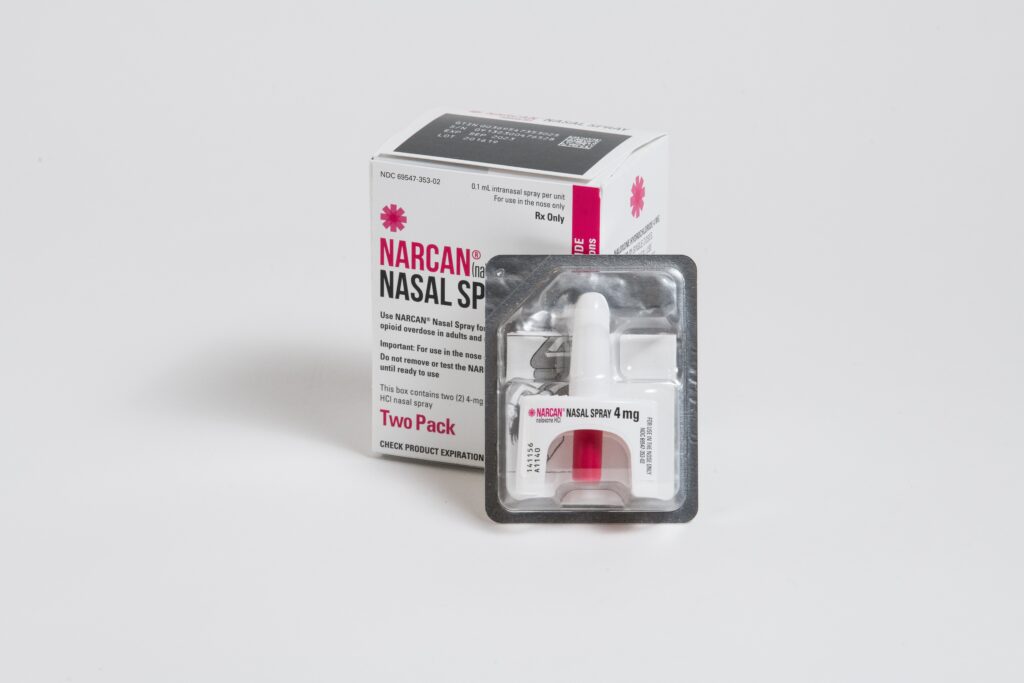It’s no surprise the COVID-19 pandemic aggravated the United States’ already rampant opioid epidemic. But what’s more surprising, and devastating, has been the increase in overdose deaths among teenagers.
Luckily, a wonder drug—Narcan, developed by a Biotechnology Innovation Organization (BIO) member—can save even more lives. Barriers to access are falling with the U.S. Food and Drug Administration (FDA) fast-tracking approval of an over-the-counter version.
Opioid epidemic meets COVID-19 pandemic
According to the National Institute on Drug Abuse (NIDA), “Opioid-involved overdose deaths rose from 21,088 in 2010 to 47,600 in 2017 and remained steady in 2018 with 46,802 deaths.”
But as shutdowns were implemented, journalists, researchers, and public health officials repeatedly sounded the alarm, reminding politicians and communities to erect support systems for a population already in the midst of a deadly epidemic.


The COVID-19 pandemic was considered “a particularly grave risk to the millions of Americans with opioid use disorder, who—already vulnerable and marginalized—are heavily dependent on face-to-face health care delivery,” wrote a team of authors in the Annals of Internal Medicine in July 2020. “Rapid and coordinated action on the part of clinicians and policymakers is required if these threats are to be mitigated.”
The pandemic removed in-person treatment and strained healthcare systems to the breaking point. This left a population of people with substance abuse disorders lacking access to some mental health services. Patients with depression were more than three times more likely to be using opioids and at greater risk of dying by overdose due to overstretched hospital real estate and staff. This severely undercut community support for patients undergoing treatment, as well as patients in the midst of active addiction.
Unsurprisingly, though overdose deaths had started to steady in 2018, they increased sharply alongside the pandemic, with 68,630 overdose deaths in 2020. Furthermore, the instance of multiple opioid use in combination rose sharply, as well.
However, a surprising trend did emerge: those dying were getting much younger.


A scary trend for parents
As COVID-19 transitioned to an endemic epidemic in tandem with the flu and other respiratory diseases, a recent Centers for Disease Control and Prevention (CDC) report observed, “from 2019 to 2021, overdose deaths among persons aged 14–18 years increased.”
A few key points from the report:
- “Median monthly overdose deaths among persons aged 10–19 years (adolescents) increased 109% from July–December 2019 to July–December 2021;
- deaths involving illicitly manufactured fentanyls (IMFs) increased 182%.
- Approximately 90% of deaths involved opioids, and 84% involved IMFs.
- Counterfeit pills were present in nearly 25% of deaths.
- Two-thirds of decedents had one or more potential bystanders present, but most provided no overdose response.
- Approximately 41% of decedents had evidence of mental health conditions or treatment.”
For parents, these numbers are astoundingly scary.
September 2022, for example, was an especially notable and difficult month for Los Angeles, with seven students dying of opioid overdoses—all around the age of 15. “It speaks to the impurities of street narcotics,” Los Angeles Police Department Chief, Michel Moore, told the Los Angeles Times. “Fentanyl is a very dangerous drug, and this dosage can range from being a painkiller to a depressant to death.”
And many drugs were bought and sold among students, with many unaware of exactly what they were buying and selling. “Officers responded to a report of a hospitalization of a minor,” continued the article, “And discovered that the boy ingested a quarter of a pill that he believed to be Percocet but that police said possibly contained fentanyl, Moore said.” In this case, the young boy survived.
“‘I’m angry that these kids had got ahold of these pills and decided to distribute them at school knowing what this can do to somebody… There’s somebody connected to them and somebody who hired them,’ said Gladys Manriques, a relative who spoke on the family’s behalf [to the Los Angeles Times].”
The trend is increasing pressure politically, socially, and on education and healthcare institutions to deal with the problem. Yet, given the decades of poor response, it is understandable why many are skeptical that fundamental change will happen quickly.
OTC Narcan could be a wonder drug
In the meantime, there is one solution that is hard not to refer to as a wonder drug: Narcan (Naloxone). Even better, it will soon be available over the counter.
While exact numbers are hard to come by, Narcan is projected to have saved 27,000 lives as of 2015. The CDC’s report stated, “From 1996 through June 2014, surveyed organizations provided naloxone kits to 152,283 laypersons and received reports of 26,463 overdose reversals. Providing opioid overdose training and naloxone kits to laypersons who might witness an opioid overdose can help reduce opioid overdose mortality.”


CDC’s report at the time was just a sample of what was happening on a larger scale. It is incredibly difficult to get an accurate number since much Narcan use is happening outside of the hospital space. While hospitals can accurately report overdose reversals as a result of Narcan usage, mortality statistics are harder to nail down. Regardless, it is undeniable that, to date, the drug has saved an untold number of lives.
As we have explained, “During an opioid overdose, the body’s automatic drive to breathe can be eliminated. Naloxone, the active ingredient in Opiant’s Narcan nasal spray, binds to the opioid receptor and blocks negative effects of the opioid.” (An added benefit of the drug is that it has no effect on anyone who is not in the midst of opioid usage or overdose.)


Interestingly, even Dr. Roger Crystal, CEO of Opiant Pharmaceuticals, the BIO member company that created Narcan, has had a chance to put his life-saving drug to use. As reported by KNBC Channel 4, “Crystal was driving with his wife through downtown Los Angeles when the medically trained couple spotted the man on a sidewalk.” The couple soon jumped out of the car and Crystal administered Narcan while his wife called 911.
“The reality is that if you see someone unresponsive, lying on the street in this country, it’s an opioid overdose until proven otherwise,” Crystal said.
FDA fast-tracks OTC Narcan
While this drug has been available in all 50 states, it often required a prescription or attending a workshop on how to administer it. However, those barriers to access may soon change. The FDA has reportedly put an OTC Narcan version of naloxone nasal spray on the fast track to approval.
“As a leader in the fight to help combat the opioid epidemic, Emergent is committed to increasing access and awareness of naloxone, and we are taking this step to help address the rising and devastating number of opioid overdoses and fatalities happening across the country,” said Robert G. Kramer, President and CEO of Emergent BioSolutions, another BIO member company that will produce the OTC Narcan. “We look forward to working with the FDA to advance our application under Priority Review designation and believe in the scientific evidence that supports the efficacy and safety of NARCAN Nasal Spray as an over-the-counter option for opioid overdose reversal.”
This is good news for several reasons. For one, the ability to get an opioid-reversal drug over the counter helps reduce the stigma. Yet, there are still some barriers that need to be addressed, including the price tag, as highlighted by Axios. The availability of OTC Narcan needs to match public health and insurance coverage of the drug. Axios explains, “Community health organizations and public health departments have absorbed some of the cost to distribute the drug free-of-cost,” while “free vending machines have popped up across the country in New York City and Los Angeles County to dispense doses.”
Diversifying access and affordability to life-saving drugs like Narcan is critically important. But this is only one step in the complex response that needs to happen in the U.S. to finally make the opioid epidemic a thing of the past.




